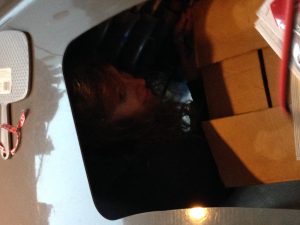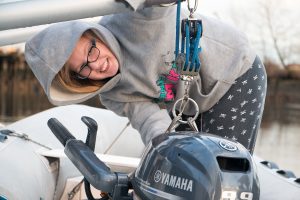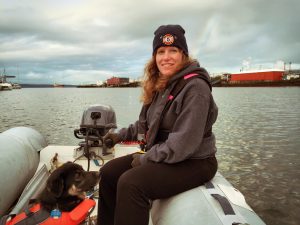Today we traveled to Quartermaster Harbor. We included myself, Ryan, India and, our borrowed child, India’s friend, Keely. The sky was blue with no expectation of wind as we made our way under the bridge. Once we cleared the waterway, we were met with a steady 6knot breeze.
Pro-tip: After taking down your Christmas lights and placing the main halyard back on the main, make sure it isn’t twisted around the lazy-jacks. This will inevitably result in a ripped sail bag. It becomes really difficult to tell if something is wrapped around a pulley when it is 50 feet in the air.
After the aforementioned snafu, we sailed across Commencement Bay at a slow but steady 3knots. When we reached the mouth of the harbor, we lowered the sails, started the engines and motored in.
We took advantage of the calm water to practice anchoring. The girls made lunch while Ryan and I honed our anchoring skills. Keely and India are expert sandwich makers.
After lunch we pulled out the boatswain’s chair and, after explaining its purpose to the girls, set up the lines for me to go up the mast. My brief flirtation with rock climbing in college did not quite prepare me for this experience.
A climbing harness, such as commonly used for rock climbing, is fitted and very secure. It looks around your waist and thighs and, if properly fitted, is quite comfortable in a resting position. A boatswain’s chair is more like a swing. Envision a padded plank with webbing on either side, which meets in the middle. Where the webbing meets there is a metal ring. You hook up the main halyard to the metal ring and are lifted aloft by raising the main halyard.
As my feet left the deck, I was met with supportive comments from below telling me, “Mom, it is just like the swings at the fair!,” and, “Just lean back and relax!” I became intimately familiar with the mast, spreaders and shrouds as I clutched them for deal life all the way up. Which brings me to the next point. The shrouds end several feet below the top of our mast. Those last few feet to the top involve truly swinging free. I did not make it to the top this time. I admit it. I chickened out. As I was lowered down, the peanut gallery was certain to let me know they were going to make it to the top.
Girl 1 did not make it to the first spreaders. Girl 2 almost made it to the bottom of the second spreaders. Mom wins.
There was zero wind as we returned to the marina. It really was quite a lovely day.




